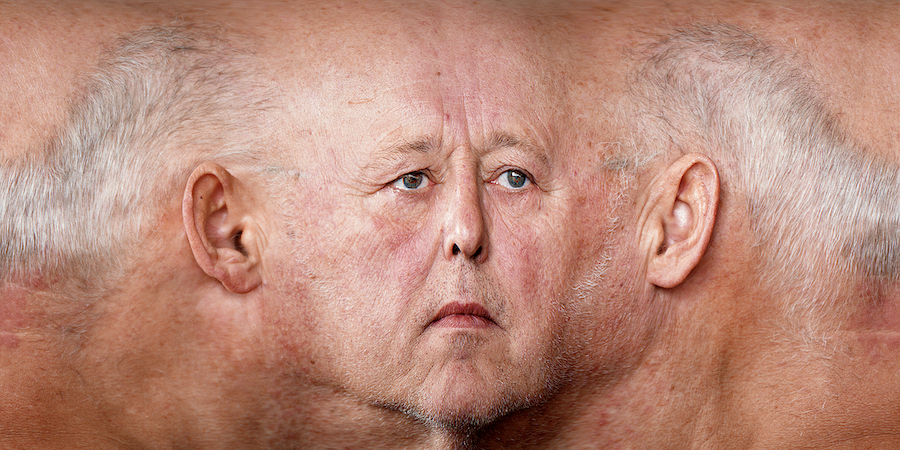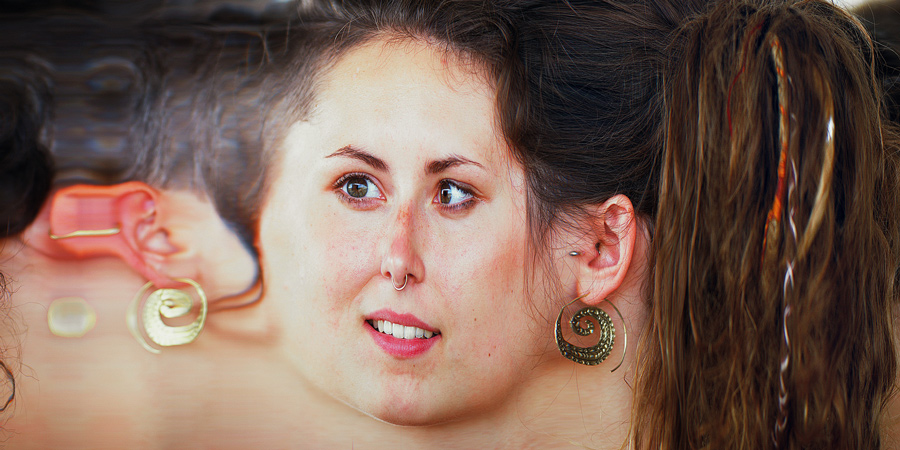KOSCHIES – SURFACES
Märkische Allgemeine Zeitung (MAZ) from 15.09.2023 (translated)
Landscapes of skin and hair
The Babelsberg artist couple Koschies have photographed heads with a special camera – their panoramas can be seen from Saturday in the “SURFACES” exhibition at the Vulkanfiberfabrik in Werder
By Peter Degener

Axel and Birgit Koschies in front of one of their panoramic portraits
Photo: Julius Frick
A bearded man’s face becomes an overgrown dunescape, a clean haircut transforms into a tree line in the altitudes of a woman’s head, a gleaming eye turns into a small body of water. The Babelsberg photo artists Axel and Birgit Koschies see landscapes in their 360-degree portraits of human heads. But those who perceive the pictures for the first time are often disturbed. The unfolded faces reveal everything all at once, irritating the beholder by their arrangement of eyes, ears and the back of the head, all in a single row – showing the surface of the skin as flat, unrolled parchment.
“The reason for this irritation stems from the fact that regular photography has impregnated our eyes.. What we perceive as normal today is the central perspective,” explains Axel Koschies. However, no hints of spatial perspective remain in the pictures which can be seen in wall-sized format from Saturday at the Vulkanfiberfabrik in Werder under the ambiguous title “Surfaces”. This is due to the unique photography technique.
“The absolute opposite of a selfie.
There are no filters, just unadorned details”
Axel Koschies
The couple have been experimenting with time-slit cameras for decades, which are mainly employed in public during the “photo finish” of a race and operate inversely to how a camera with central shutter does. A time-slit camera does not record space, but only an extremely thin vertical line – yet it continously records, similar to film. Only when something moves in front of the narrow recording slit it does become visible. “Temporal succession becomes spatial juxtaposition,” explains Birgit Koschies.
Accordingly, the panoramic head shots show the slow rotation of the model in front of the recording slit. The people portrayed sat in the studio on a chair that rotated around its own axis once every 30 seconds. “A picture like this also maps the emotive response to that half minute of being recorded. It’s the complete opposite of a selfie. There are no filters, just unadorned details,” says Axel Koschies. The art-historical associations are diverse and range from archaic death masks to Pablo Picasso, who dissected the faces of his models and reassembled them, enabling a simultaneous lateral and frontal view.
Most of the models were photographed up to 100 times before the artists deemed a picture worthy. “One eye often shifts out of place,” says Birgit Koschies. This is because several seconds pass between the recording of the individual eyes. In some pictures, the eyes are therefore closed, giving the impression of relaxed sleep.
The artists do not reveal the identities of those in the pictures. “There are well-known musicians, professional athletes, millionaires, but also homeless people, former prisoners, students, people from the supermarket checkout, even faces from Potsdam and Werder,” they list. The names remain secret, accessories that give away their origins are removed. “Concealing their origins is a particularly interesting aspect. We are often confronted with assumptions and have learnt how much they differ when assessing the personal backgrounds of the people portrayed,” they explain. The viewer sees the whole face – and yet everyone recognises someone else in it.
“SURFACES” exhibition in September 2023, 12-6 p.m. in the historic Vulkanfiber factory, Adolf-Damaschke-Str. 56-58, D – 14542 Werder

It takes 30 seconds to rotate the model in front of the camera’s static lens
Photos: Koschies

A focussed look was difficult for some models – they therefore kept their eyes closed

As in some of Picasso’s pictures, the young woman can be seen simultaneously from the front and partly in profile